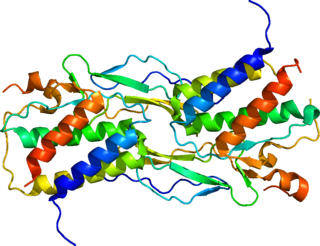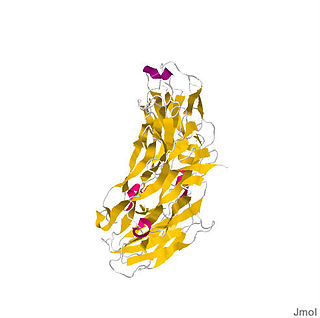Related Research Articles

Interleukin 10 (IL-10), also known as human cytokine synthesis inhibitory factor (CSIF), is an anti-inflammatory cytokine. In humans, interleukin 10 is encoded by the IL10 gene. IL-10 signals through a receptor complex consisting of two IL-10 receptor-1 and two IL-10 receptor-2 proteins. Consequently, the functional receptor consists of four IL-10 receptor molecules. IL-10 binding induces STAT3 signalling via the phosphorylation of the cytoplasmic tails of IL-10 receptor 1 + IL-10 receptor 2 by JAK1 and Tyk2 respectively.

The common gamma chain (γc), also known as interleukin-2 receptor subunit gamma or IL-2RG, is a cytokine receptor sub-unit that is common to the receptor complexes for at least six different interleukin receptors: IL-2, IL-4, IL-7, IL-9, IL-15 and interleukin-21 receptor. The γc glycoprotein is a member of the type I cytokine receptor family expressed on most lymphocyte populations, and its gene is found on the X-chromosome of mammals.

Interleukin 11 (IL-11) is a protein that in humans is encoded by the IL11 gene.

Interleukin-15 (IL-15) is a cytokine with structural similarity to Interleukin-2 (IL-2). Like IL-2, IL-15 binds to and signals through a complex composed of IL-2/IL-15 receptor beta chain (CD122) and the common gamma chain. IL-15 is secreted by mononuclear phagocytes following infection by virus(es). This cytokine induces the proliferation of natural killer cells, i.e. cells of the innate immune system whose principal role is to kill virally infected cells.

Interleukin-18 is a protein which in humans is encoded by the IL18 gene. The protein encoded by this gene is a proinflammatory cytokine. Many cell types, both hematopoietic cells and non-hematopoietic cells, have the potential to produce IL-18. It was first described in 1989 as a factor that induced interferon-γ (IFN-γ) production in mouse spleen cells. Originally, IL-18 production was recognized in Kupffer cells, liver-resident macrophages. However, IL-18 is constitutively expressed in non-hematopoietic cells, such as intestinal epithelial cells, keratinocytes, and endothelial cells. IL-18 can modulate both innate and adaptive immunity and its dysregulation can cause autoimmune or inflammatory diseases.

Pro-interleukin-16 is a protein that in humans is encoded by the IL16 gene. This gene was discovered in 1982 at Boston University by Dr. David Center and Dr. William Cruikshank.

Interleukin 6 receptor (IL6R) also known as CD126 is a type I cytokine receptor.

Interleukin enhancer-binding factor 3 is a protein that in humans is encoded by the ILF3 gene.

Interleukin 1 receptor, type II (IL-1R2) also known as CD121b is an interleukin receptor. IL1R2 also denotes its human gene.

Interleukin-12 receptor, beta 1, or IL-12Rβ1 in short, is a subunit of the interleukin 12 receptor. IL12RB1, is the name of its human gene. IL-12Rβ1 is also known as CD212.

Interleukin 13 receptor, alpha 1, also known as IL13RA1 and CD213A1, is a human gene.

Interleukin-13 receptor subunit alpha-2 (IL-13Rα2), also known as CD213A2, is a membrane bound protein that in humans is encoded by the IL13RA2 gene.

Interleukin 37 (IL-37), also known as IL-1 family member 7 (IL-1F7), is an anti-inflammatory cytokine. Interleukines are cytokines that make an important part of immune signaling. It belongs to the interleukin-1 family. This protein is in humans encoded by the IL37 gene located on the chromosome 2.

Interleukin 11 receptor, alpha subunit is a subunit of the interleukin 11 receptor. IL11RA is its human gene.

Interleukin-2 receptor subunit beta is a protein that in humans is encoded by the IL2RB gene. Also known as CD122; IL15RB; P70-75.

Interleukin 18 receptor accessory protein, also known as IL18RAP and CDw218b, is a human gene.

Interleukin 3 receptor, alpha (IL3RA), also known as CD123, is a human gene.

Interleukin-17 receptor (IL-17R) is a cytokine receptor which belongs to new subfamily of receptors binding proinflammatory cytokine interleukin 17A, a member of IL-17 family ligands produced by T helper 17 cells (Th17). IL-17R family consists of 5 members: IL-17RA, IL-17RB, IL-17RC, IL-17RD and IL-17RE. Functional IL-17R is a transmembrane receptor complex usually consisting of one IL-17RA, which is a founding member of the family, and second other family subunit, thus forming heteromeric receptor binding different ligands. IL-17A, a founding member of IL-17 ligand family binds to heteromeric IL-17RA/RC receptor complex. IL-17RB binds preferentially IL-17B and IL-17E and heteromeric IL-17RA/RE complex binds IL-17C. However, there is still unknown ligand for IL-17RD. The first identified member IL-17RA is located on human chromosome 22, whereas other subunits IL-17RB to IL-17RD are encoded within human chromosome 3.

The Interleukin-1 family is a group of 11 cytokines that plays a central role in the regulation of immune and inflammatory responses to infections or sterile insults.

Interleukin-23 (IL-23) is a heterodimeric cytokine composed of an IL12B (IL-12p40) subunit and the IL23A (IL-23p19) subunit. IL-23 is part of IL-12 family of cytokines. A functional receptor for IL-23 has been identified and is composed of IL-12R β1 and IL-23R. Adnectin-2 is binding to IL-23 and compete with IL-23/IL-23R. mRNA of IL-23R is 2,8 kB in length and includes 12 exons. The translated protein contains 629 amino acids, which is a type I penetrating protein includes signal peptide, an N-terminal fibronectin III-like domain and an intracellular part contains 3 potential tyrosine phosphorylation domains. There are 24 variants of splicing of IL-23R in mitogen-activated lymphocytes. IL-23R has some single nucleotide polymorphisms in the domain of binding IL-23 so there can be differences in activation of Th17. There is also variant of IL-23R which has just extracellular part and it´s known as soluble IL-23R. This form can compete with membrane form to bind IL-23 and there can be difference in activation of Th17 immune response and regulation of inflammation and immune function.
References
- ↑ Sergi B, Penttila I (2004). "Interleukin 18 receptor". J. Biol. Regul. Homeost. Agents. 18 (1): 55–61. PMID 15323361.
- ↑ Wu C, Sakorafas P, Miller R, McCarthy D, Scesney S, Dixon R, Ghayur T (2003). "IL-18 receptor beta-induced changes in the presentation of IL-18 binding sites affect ligand binding and signal transduction". J. Immunol. 170 (11): 5571–7. doi: 10.4049/jimmunol.170.11.5571 . PMID 12759435.
- ↑ Huang, H.; Yu, H.; Chan, S.; Lee, C.; Wang, H.; Soong, Y. (2010). "Eutopic endometrial interleukin-18 system mRNA and protein expression at the level of endometrial-myometrial interface in adenomyosis patients". Fertility and Sterility. 94 (1): 33–39. doi:10.1016/j.fertnstert.2009.01.132. PMID 19394601.